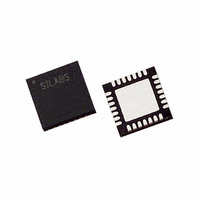C8051F313-GM Silicon Laboratories Inc, C8051F313-GM Datasheet - Page 124

C8051F313-GM
Manufacturer Part Number
C8051F313-GM
Description
IC 8051 MCU 8K FLASH 28MLP
Manufacturer
Silicon Laboratories Inc
Series
C8051F31xr
Specifications of C8051F313-GM
Core Size
8-Bit
Program Memory Size
8KB (8K x 8)
Oscillator Type
Internal
Core Processor
8051
Speed
25MHz
Connectivity
SMBus (2-Wire/I²C), SPI, UART/USART
Peripherals
POR, PWM, Temp Sensor, WDT
Number Of I /o
25
Program Memory Type
FLASH
Ram Size
1.25K x 8
Voltage - Supply (vcc/vdd)
2.7 V ~ 3.6 V
Data Converters
A/D 17x10b
Operating Temperature
-40°C ~ 85°C
Package / Case
28-VQFN Exposed Pad, 28-HVQFN, 28-SQFN, 28-DHVQFN
No. Of I/o's
25
Ram Memory Size
1280Byte
Cpu Speed
25MHz
No. Of Timers
4
No. Of Pwm Channels
5
Digital Ic Case
RoHS Compliant
Rohs Compliant
Yes
Processor Series
C8051F3x
Core
8051
Data Bus Width
8 bit
Data Ram Size
1.25 KB
Interface Type
I2C, SMBus, SPI, UART
Maximum Clock Frequency
25 MHz
Number Of Programmable I/os
25
Number Of Timers
5
Operating Supply Voltage
2.7 V to 3.6 V
Maximum Operating Temperature
+ 85 C
Mounting Style
SMD/SMT
3rd Party Development Tools
PK51, CA51, A51, ULINK2
Development Tools By Supplier
C8051F310DK
Minimum Operating Temperature
- 40 C
On-chip Adc
10 bit
Data Rom Size
128 B
Height
0.88 mm
Length
5 mm
Supply Voltage (max)
3.6 V
Supply Voltage (min)
2.7 V
Width
5 mm
Lead Free Status / RoHS Status
Lead free / RoHS Compliant
For Use With
770-1006 - ISP 4PORT FOR SILABS C8051F MCU
Eeprom Size
-
Lead Free Status / Rohs Status
Details
Other names
336-1256
C8051F310/1/2/3/4/5/6/7
12.2. External Oscillator Drive Circuit
The external oscillator circuit may drive an external crystal, ceramic resonator, capacitor, or RC network. A
CMOS clock may also provide a clock input. For a crystal or ceramic resonator configuration, the crys-
tal/resonator must be wired across the XTAL1 and XTAL2 pins as shown in Option 1 of Figure 12.1. A
10 Mresistor also must be wired across the XTAL2 and XTAL1 pins for the crystal/resonator configura-
tion. In RC, capacitor, or CMOS clock configuration, the clock source should be wired to the XTAL2 pin as
shown in Option 2, 3, or 4 of Figure 12.1. The type of external oscillator must be selected in the OSCXCN
register, and the frequency control bits (XFCN) must be selected appropriately (see SFR Definition 12.4).
Important Note on External Oscillator Usage: Port pins must be configured when using the external
oscillator circuit. When the external oscillator drive circuit is enabled in crystal/resonator mode, Port pins
P0.2 and P0.3 are used as XTAL1 and XTAL2 respectively. When the external oscillator drive circuit is
enabled in capacitor, RC, or CMOS clock mode, Port pin P0.3 is used as XTAL2. The Port I/O Crossbar
should be configured to skip the Port pins used by the oscillator circuit; see
Section “13.1. Priority Cross-
bar Decoder” on page 131
for Crossbar configuration. Additionally, when using the external oscillator cir-
cuit in crystal/resonator, capacitor, or RC mode, the associated Port pins should be configured as analog
inputs. In CMOS clock mode, the associated pin should be configured as a digital input. See
Section
“13.2. Port I/O Initialization” on page 133
for details on Port input mode selection.
12.3. System Clock Selection
The CLKSL0 bit in register CLKSEL selects which oscillator is used as the system clock. CLKSL0 must be
set to ‘1’ for the system clock to run from the external oscillator; however the external oscillator may still
clock certain peripherals (timers, PCA) when the internal oscillator is selected as the system clock. The
system clock may be switched on-the-fly between the internal and external oscillator, so long as the
selected oscillator is enabled and has settled. The internal oscillator requires little start-up time and may be
selected as the system clock immediately following the OSCICN write that enables the internal oscillator.
External crystals and ceramic resonators typically require a start-up time before they are settled and ready
for use as the system clock. The Crystal Valid Flag (XTLVLD in register OSCXCN) is set to ‘1’ by hardware
when the external oscillator is settled. To avoid reading a false XTLVLD, in crystal mode software
should delay at least 1 ms between enabling the external oscillator and checking XTLVLD. RC and
C modes typically require no startup time.
124
Rev. 1.7










